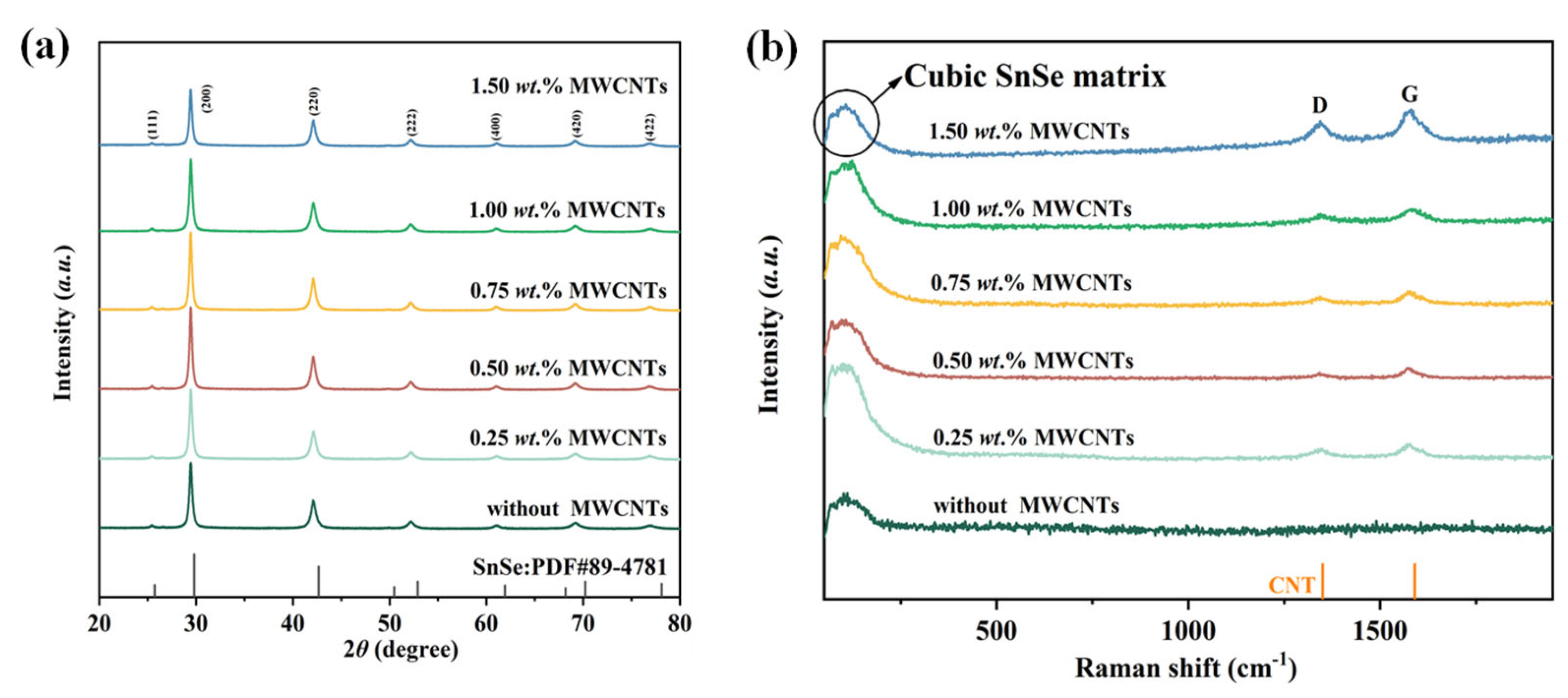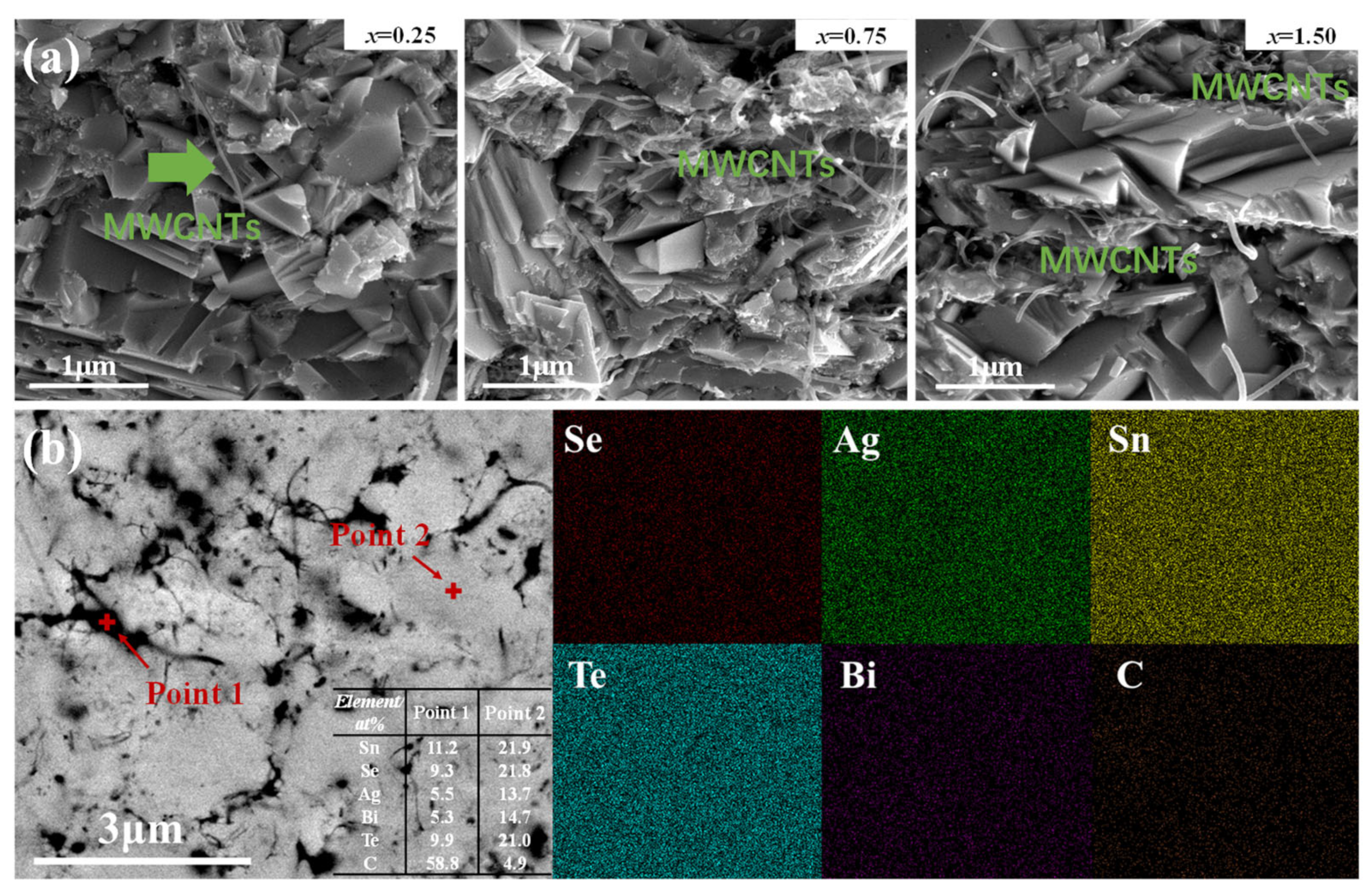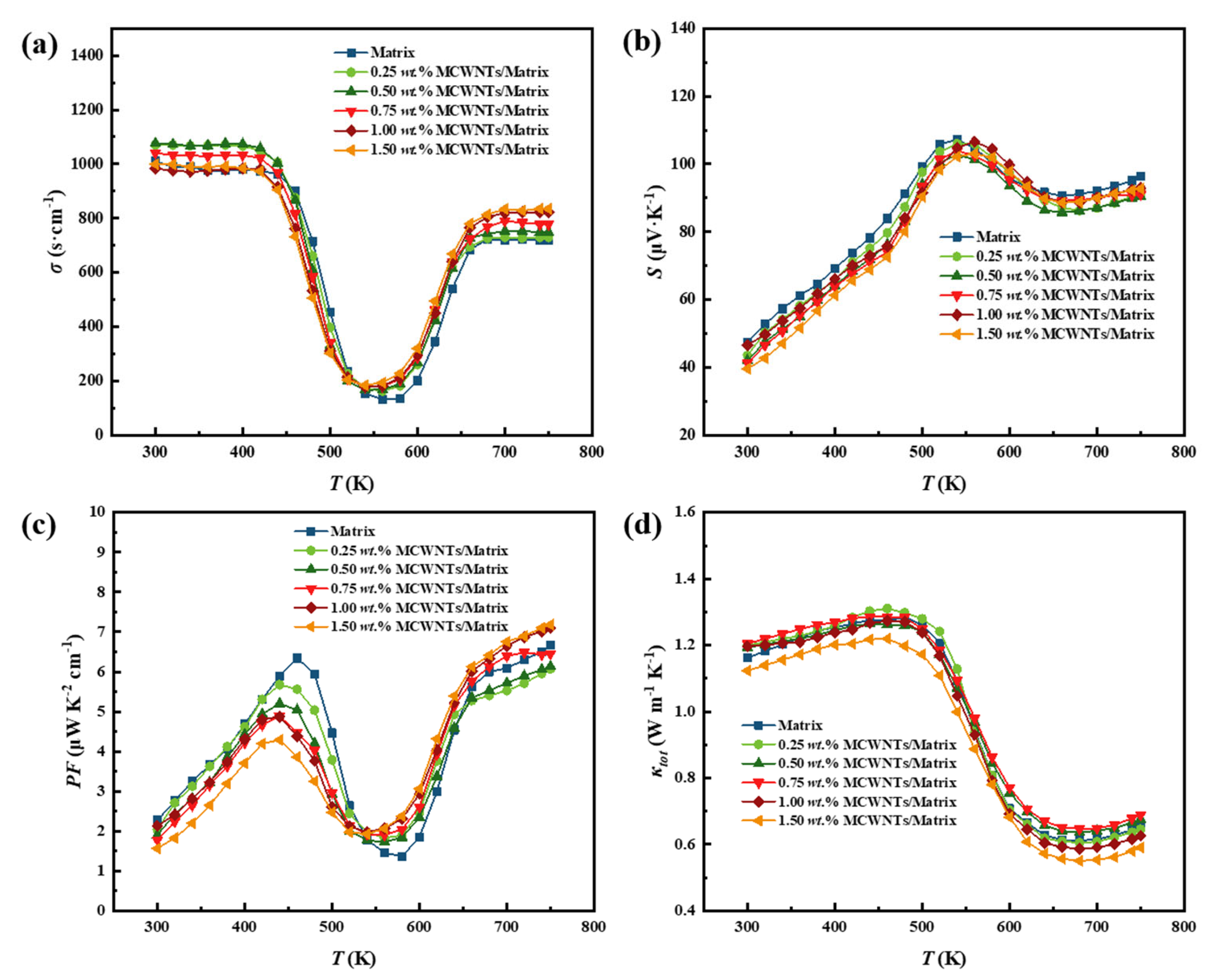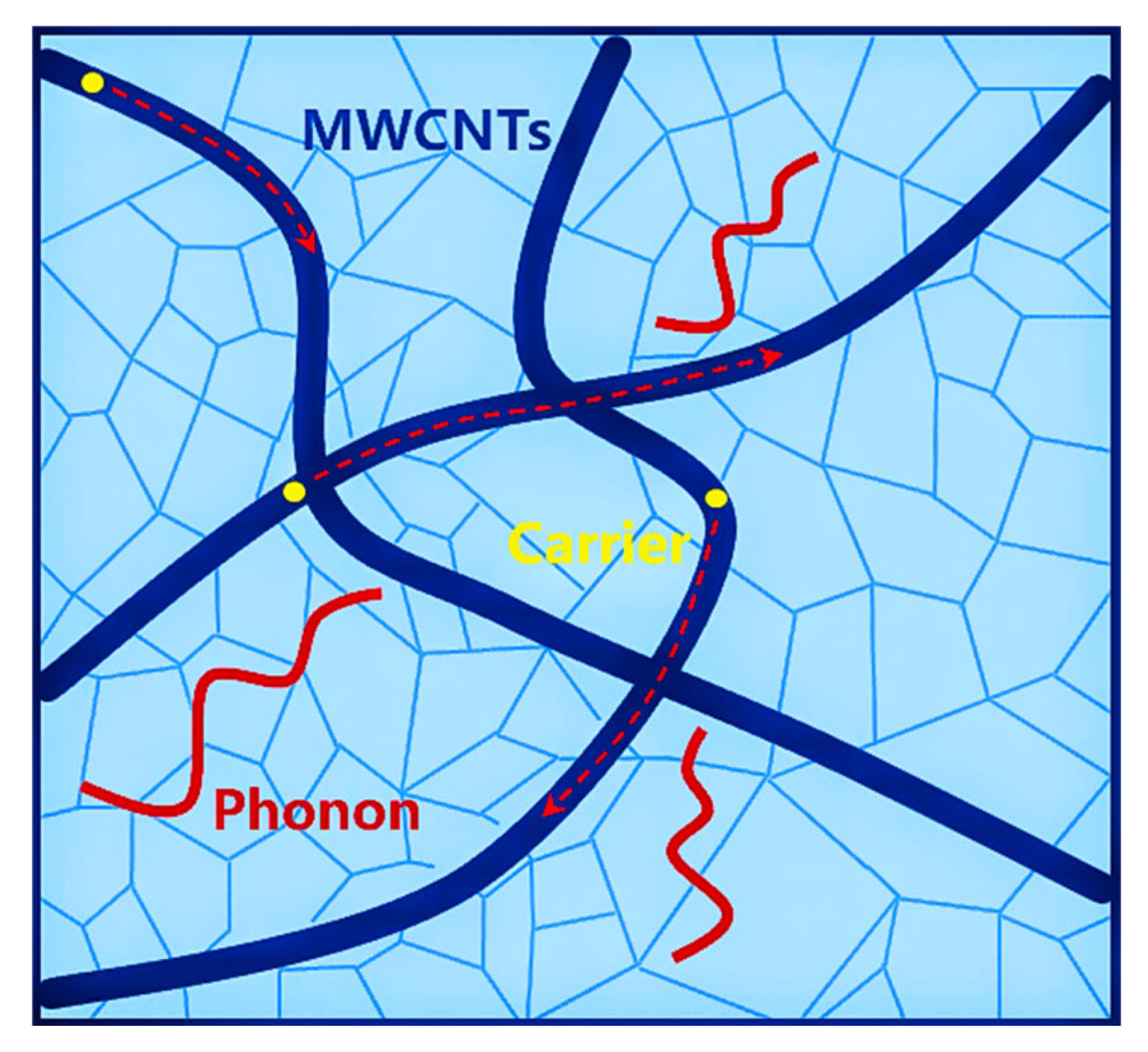Enhanced Thermoelectric Properties in Cubic Sn0.50Ag0.25Bi0.25Se0.50Te0.50 via MWCNTs Incorporation
Abstract
:1. Introduction
2. Materials and Methods
2.1. Synthesis of Sn0.50Ag0.25Bi0.25Se0.50Te0.50 Powder
2.2. Preparation of MWCNTs/Sn0.50Ag0.25Bi0.25Se0.50Te0.50 Composites
2.3. Characterization
3. Results and Discussion
4. Conclusions
Author Contributions
Funding
Data Availability Statement
Conflicts of Interest
References
- He, J.; Tritt, T.M. Advances in thermoelectric materials research: Looking back and moving forward. Science 2017, 357, eaak9997. [Google Scholar] [CrossRef] [PubMed]
- Shi, X.; Chen, L.; Uher, C. Recent advances in high-performance bulk thermoelectric materials. Int. Mater. Rev. 2016, 61, 379–415. [Google Scholar] [CrossRef]
- Ortega, S.; Ibáñez, M.; Liu, Y.; Zhang, Y.; Kovalenko, M.V.; Cadavid, D. Bottom-up engineering of thermoelectric nanomaterials and devices from solution-processed nanoparticle building blocks. Chem. Soc. Rev. 2017, 46, 3510–3528. [Google Scholar] [CrossRef] [PubMed]
- Gayner, C.; Kar, K.K. Recent advances in thermoelectric materials. Prog. Mater. Sci. 2016, 83, 330–382. [Google Scholar] [CrossRef]
- Sootsman, J.R.; Chung, D.Y.; Kanatzidis, M.G. New and old concepts in thermoelectric materials. Angew. Chem. Int. Ed. 2009, 48, 8616–8639. [Google Scholar] [CrossRef]
- Snyder, G.J.; Toberer, E.S. Complex thermoelectric materials. Nat. Mater. 2008, 7, 105–114. [Google Scholar] [CrossRef]
- Bell, L.E. Cooling, heating, generating power, and recovering waste heat with thermoelectric systems. Science 2008, 321, 1457. [Google Scholar] [CrossRef]
- Pei, Y.; LaLonde, A.D.; Wang, H.; Snyder, G.J. Low effective mass leading to high thermoelectric performance. Energy Environ. Sci. 2012, 5, 7963–7969. [Google Scholar] [CrossRef]
- Mishra, S.K.; Satpathy, S.; Jepsen, O. Electronic structure and thermoelectric properties of bismuth telluride and bismuth selenide. J. Phys.-Condens. Matter 1997, 9, 461. [Google Scholar] [CrossRef]
- Roychowdhury, S.; Ghosh, T.; Arora, R.; Samanta, M.; Lin, X.; Singh, N.K.; Soni, A.; He, J.; Waghmare, U.V.; Biswas, K. Enhanced atomic ordering leads to high thermoelectric performance in AgSbTe2. Science 2021, 371, 722–727. [Google Scholar] [CrossRef]
- Biswas, K.; He, J.; Blum, I.D.; Wu, C.I.; Hogan, T.P.; Seidman, D.N.; Dravid, V.P.; Kanatzidis, M.G. High-performance bulk thermoelectrics with all-scale hierarchical architectures. Nature 2012, 489, 414–418. [Google Scholar] [CrossRef] [PubMed]
- Poudel, B.; Hao, Q.; Ma, Y.; Lan, Y.; Minnich, A.; Yu, B.; Yan, X.; Wang, D.; Muto, A.; Vashaee, D.; et al. High-thermoelectric performance of nanostructured bismuth antimony telluride bulk alloys. Science 2008, 320, 634–638. [Google Scholar] [CrossRef] [PubMed]
- Jiang, B.; Yu, Y.; Cui, J.; Liu, X.; Xie, L.; Liao, J.; Zhang, Q.; Huang, Y.; Ning, S.; Jia, B.; et al. High-entropy-stabilized chalcogenides with high thermoelectric performance. Science 2021, 371, 830–834. [Google Scholar] [CrossRef] [PubMed]
- Wu, H.J.; Zhao, L.D.; Zheng, F.S.; Wu, D.; Pei, Y.L.; Tong, X.; Kanatzidis, M.G.; He, J.Q. Broad temperature plateau for thermoelectric figure of merit ZT > 2 in phase-separated PbTe0.7S0.3. Nat. Commun. 2014, 5, 4515. [Google Scholar] [CrossRef]
- Shen, D.; Tai, S.T.; Liu, K.; Wang, W.; Li, H.; Theja, V.C.; Chen, C.; Chen, Y. Point Defect Scattering and Phonon Softening for Achieving High Thermoelectric Performance in p-Type ZnSb with Optimal Carrier Concentration. ACS Appl. Mater. Interfaces 2025, 17, 17036–17044. [Google Scholar] [CrossRef]
- Chen, Y.X.; Ge, Z.H.; Yin, M.; Feng, D.; Huang, X.Q.; Zhao, W.; He, J. Understanding of the extremely low thermal conductivity in high-performance polycrystalline SnSe through potassium doping. Adv. Funct. Mater. 2016, 26, 6836–6845. [Google Scholar] [CrossRef]
- Zhao, L.; Lo, S.H.; Zhang, Y.; Sun, H.; Tan, G.; Uher, C.; Wolvrton, C.; Dravid, V.P.; Kanatzidis, M.G. Ultralow thermal conductivity and high thermoelectric figure of merit in SnSe crystals. Nature 2014, 508, 373–377. [Google Scholar] [CrossRef]
- Li, J.; Li, D.; Qin, X.; Zhang, J. Enhanced thermoelectric performance of p-type SnSe doped with Zn. Scripta Mater. 2017, 126, 6–10. [Google Scholar] [CrossRef]
- Wubieneh, T.A.; Chen, C.; Wei, P.; Chen, S.Y.; Chen, Y.Y. The effects of Ge doping on the thermoelectric performance of p-type polycrystalline SnSe. RSC Adv. 2016, 6, 114825–114829. [Google Scholar] [CrossRef]
- Chu, F.; Zhang, Q.; Zhou, Z.; Hou, D.; Wang, L.; Jiang, W. Enhanced thermoelectric and mechanical properties of Na-doped polycrystalline SnSe thermoelectric materials via CNTs dispersion. J. Alloys Compd. 2018, 741, 756–764. [Google Scholar] [CrossRef]
- Li, J.; Xu, J.; Wang, H.; Li, J.; Xu, J.; Wang, H.; Liu, G.Q.; Tan, X.; Shao, H.; Hu, H.; et al. Enhanced thermoelectric performance in p-type polycrystalline SnSe by Cu doping. J. Mater. Sci-Mater. Electron. 2018, 29, 18727–18732. [Google Scholar] [CrossRef]
- Sun, Y.; Zhong, Z.; Shirakawa, T.; Franchini, C.; Li, D.; Li, Y.; Yunoki, S.; Chen, X.Q. Rocksalt SnS and SnSe: Native topological crystalline insulators. Phys. Rev. B 2013, 88, 235122–235128. [Google Scholar] [CrossRef]
- Zhang, Y.; Ke, X.; Chen, C.; Yang, J.; Kent, P.R.C. Thermodynamic properties of PbTe, PbSe, and PbS: First-principles study. Phys. Rev. B 2009, 80, 024304–024326. [Google Scholar] [CrossRef]
- Zhao, L.D.; Dravid, V.P.; Kanatzidis, M.G. The panoscopic approach to high performance thermoelectrics. Energy Environ. Sci. 2014, 7, 251–268. [Google Scholar] [CrossRef]
- Zhu, T.; Liu, Y.; Fu, C.; Heremans, J.P.; Snyder, J.G.; Zhao, X. Compromise and synergy in high-efficiency thermoelectric materials. Adv. Mater. 2017, 29, 1605884. [Google Scholar] [CrossRef]
- Shi, X.L.; Zou, J.; Chen, Z.G. Advanced thermoelectric design: From materials and structures to devices. Chem. Rev. 2020, 120, 7399–7515. [Google Scholar] [CrossRef]
- Wang, H.X.; Mao, L.S.; Tan, X.; Tan, X.; Liu, G.Q.; Xu, J.; Shao, H.; Hu, H.; Jiang, J. Nontrivial thermoelectric behavior in cubic SnSe driven by spin-orbit coupling. Nano Energy 2018, 51, 649–655. [Google Scholar] [CrossRef]
- Dutta, M.; Pal, K.; Etter, M.; Waghmare, U.V.; Biswas, K. Emphanisis in cubic (SnSe)0.5(AgSbSe2)0.5: Dynamical off-centering of anion leads to low thermal conductivity and high thermoelectric performance. J. Am. Chem. Soc. 2021, 143, 16839–16848. [Google Scholar] [CrossRef]
- Fu, Y.; Xu, J.; Liu, G.Q.; Tan, X.; Li, Z.; Wang, X.; Shao, H.; Jiang, H.; Liang, H.; Jiang, J. Study on thermoelectric properties of polycrystalline SnSe by Ge doping. J. Electron. Mater. 2017, 46, 3182–3186. [Google Scholar] [CrossRef]
- Li, D.; Li, J.C.; Qin, X.Y.; Xin, H.X.; Song, C.J.; Wang, L. Enhanced thermoelectric performance in SnSe based composites with PbTe nano inclusions. Energy 2016, 116, 861–866. [Google Scholar] [CrossRef]
- Zhao, T.; Yang, L.Z.; Zhou, Y.; Liao, H.J.; Huang, Z.Y.; Li, J.; Lu, X.; Zhou, X.Y. Thermoelectric performance of (AgBiTe2)1-x(SnTe)x with stable cubic enabled by enhanced configurational entropy. Rare Metals 2022, 41, 4149–4155. [Google Scholar] [CrossRef]
- Nie, C.; Wang, C.; Xu, Y.; Liu, Y.; Niu, X.; Li, S.; Gong, Y.; Hou, Y.; Zhang, X.; Zhang, D.; et al. Band modification and localized lattice engineering leads to high thermoelectric performance in Ge and Bi codoped SnTe-AgBiTe2 alloys. Small 2023, 19, 2301298–2301307. [Google Scholar] [CrossRef] [PubMed]
- Wang, H.X.; Hu, H.Y.; Man, N.; Xiong, C.L.; Xiao, Y.K.; Tan, X.J.; Liu, G.Q.; Jiang, J. Band flattening and phonon-defect scattering in cubic SnSe–AgSbTe2 alloy for thermoelectric enhancement. Mater. Today Phys. 2021, 16, 100298. [Google Scholar] [CrossRef]
- Zhu, J.L.; Bo, L.; Kong, J.B.; Hou, Y.B.; Zhao, L.H.; Li, C.C.; Zhao, D.G. Enhanced thermoelectric and mechanical properties of polycrystalline cubic SnSe by AgBiTe2 alloying. J. Alloys Comp. 2024, 971, 172754. [Google Scholar] [CrossRef]
- Lin, N.; Han, S.; Ghosh, T.; Schön, C.F.; Kim, D.; Frank, J.; Yu, Y.; Schmidt, T.; Ying, P.J.; Zhu, Y.K. Metavalent bonding in cubic SnSe alloys improves thermoelectric properties over a broad temperature range. Adv. Funct. Mater. 2024, 34, 2315652. [Google Scholar] [CrossRef]
- Roychowdhury, S.; Ghosh, T.; Arora, R.; Waghmare, U.V.; Biswas, K. Stabilizing n-type cubic GeSe by entropy-driven alloying of AgBiSe2: Ultralow thermal conductivity and promising thermoelectric performance. Angew. Chem. Int. Ed. 2018, 130, 15387–15391. [Google Scholar] [CrossRef]
- Zhang, Q.; Wang, W.; Li, J.; Zhu, J.; Wang, L.; Zhu, M.; Jiang, W. Preparation and thermoelectric properties of multi-walled carbon nanotube/polyaniline hybrid nanocomposites. J. Mater. Chem. A 2013, 1, 12109–12114. [Google Scholar] [CrossRef]
- Si, R.; Zhang, Z.; Liu, C.; Peng, Y.; Bai, X.; Feng, B.; Chen, J.; Gao, J.; Miao, L. Decoupled electron and phonon transport in thermoelectric GeTe compounded with multi-walled carbon nanotubes. Mater. Today Phys. 2023, 34, 101081. [Google Scholar] [CrossRef]
- Sun, X.; Wang, Y.; Li, K.; Wang, J.; Dai, X.; Chong, D.; Yan, J.; Wang, H. Anisotropic electrical conductivity and isotropic seebeck coefficient feature induced high thermoelectric power factor >1800 µW m−1 K−2 in MWCNT films. Adv. Funct. Mater. 2022, 32, 2203080. [Google Scholar] [CrossRef]
- Kuznetsov, V.L.; Bokova-Sirosh, S.N.; Moseenkov, S.I.; Ishchenko, A.V.; Krasnikov, D.V.; Kazakova, M.A.; Romanenko, A.I.; Tkachev, E.N.; ObraZTsova, E.D. Raman spectra for characterization of defective CVD multi-walled carbon nanotubes. Phys. Status Solidi (B) 2014, 251, 2444–2450. [Google Scholar] [CrossRef]
- Mao, X.Y.; Shi, X.L.; Zhai, L.C.; Liu, W.D.; Chen, Y.X.; Gao, H.; Li, M.; Wang, D.Z.; Wu, H.; Zheng, Z.H.; et al. High thermoelectric and mechanical performance in the n-type polycrystalline SnSe incorporated with multi-walled carbon nanotubes. J. Mater. Sci. Technol. 2022, 114, 55–61. [Google Scholar] [CrossRef]
- Spalva, E.; Niherysh, K.; Andzane, J.; Felsharuk, A.; Erts, D. Interface-induced enhancement of thermoelectric properties of Bi2Se3-n-type MWCNT heterostructures revealed by magnetotransport analysis. J. Alloys Compd. 2025, 1020, 179299. [Google Scholar] [CrossRef]
- Ahmad, K.; Almutairi, Z. Enhanced thermoelectric properties of bismuth telluride (Bi2Te3) and multiwall carbon nanotube (MWCNT) composites. Mater. Today Commun. 2023, 35, 106228. [Google Scholar] [CrossRef]
- Shojaei, M.; Shokuhfar, A.; Zolriasatein, A.; Moghaddam, A.O. Enhanced thermoelectric performance of CuAlS2 by adding multi-walled carbon nanotubes. Adv. Powder Technol. 2022, 33, 103445. [Google Scholar] [CrossRef]
- Cherif, Y.B.; Mekhalif, Z.; Mekki, A.; Satah, Z.B.D. Effect of MWCNTs surface functionalization group nature on the thermoelectric power factor of PPy/MWCNTs nanocomposites. Synth. Metals 2022, 291, 117196. [Google Scholar] [CrossRef]
- Piao, R.; Cui, Z.; Oh, T.; Kim, S.; Jeong, J.W.; Yoo, D.Y. Synergistic effect of nickel and graphite powders on the thermoelectric properties of ultra-high-performance concrete containing steel fibers and MWCNTs. Cem. Concr. Comp. 2024, 154, 105778. [Google Scholar] [CrossRef]
- Ignatious, V.; Raveendran, N.; Prabhakaran, A.; Puli, Y.T.; Chakkooth, V.; Deb, B. MWCNT/Thienothiophene based All-Organic thermoelectric composites: Enhanced performance by realigning of the Fermi level through doping. Chem. Eng. J. 2021, 409, 128294. [Google Scholar] [CrossRef]
- Li, Z.Q.; Wang, Y.P.; Liu, D.R.; Hong, T.; Qin, B.C.; Gao, X.; Zhao, L.D. Attempts to realize promising thermoelectric performance in n-type polycrystalline SnSe with a cubic structure. J. Mater. Chem. A 2025, 13, 4899–4907. [Google Scholar] [CrossRef]
- Wang, Y.; Qin, B.; Hong, T.; Su, L.; Gao, X.; Wang, D.; Zhao, L.D. Enhanced thermoelectric perfromance in cubic form of SnSe stabilized through enformatingly alloying AgSbTe2. Acta Mater. 2022, 227, 117681. [Google Scholar] [CrossRef]







| x (wt.%) | Density (g/cm3) | Densification (%) | n (1021 cm−3) | μ (cm2 V−1 s−1) | I(D)/I(G) |
|---|---|---|---|---|---|
| 0 | 6.70 | 97.95 | 1.11 (±0.03) | 5.72 (±0.06) | - |
| 0.25 | 6.74 | 98.51 | 2.21 (±0.10) | 3.04 (±0.13) | 0.641 |
| 0.50 | 6.76 | 98.80 | 2.23 (±0.13) | 3.03 (±0.04) | 0.555 |
| 0.75 | 6.75 | 98.66 | 2.06 (±0.08) | 3.15 (±0.09) | 0.575 |
| 1.00 | 6.72 | 98.22 | 1.94 (±0.07) | 3.20 (±0.11) | 0.627 |
| 1.50 | 6.71 | 98.07 | 1.67 (±0.09) | 3.76 (±0.07) | 0.598 |
Disclaimer/Publisher’s Note: The statements, opinions and data contained in all publications are solely those of the individual author(s) and contributor(s) and not of MDPI and/or the editor(s). MDPI and/or the editor(s) disclaim responsibility for any injury to people or property resulting from any ideas, methods, instructions or products referred to in the content. |
© 2025 by the authors. Licensee MDPI, Basel, Switzerland. This article is an open access article distributed under the terms and conditions of the Creative Commons Attribution (CC BY) license (https://creativecommons.org/licenses/by/4.0/).
Share and Cite
Tan, Z.; Zeng, Z.; Zhu, J.; Wang, W.; Bo, L.; Liu, X.; Li, C.; Zhao, D. Enhanced Thermoelectric Properties in Cubic Sn0.50Ag0.25Bi0.25Se0.50Te0.50 via MWCNTs Incorporation. Crystals 2025, 15, 365. https://doi.org/10.3390/cryst15040365
Tan Z, Zeng Z, Zhu J, Wang W, Bo L, Liu X, Li C, Zhao D. Enhanced Thermoelectric Properties in Cubic Sn0.50Ag0.25Bi0.25Se0.50Te0.50 via MWCNTs Incorporation. Crystals. 2025; 15(4):365. https://doi.org/10.3390/cryst15040365
Chicago/Turabian StyleTan, Zhewen, Zhaowei Zeng, Junliang Zhu, Wenying Wang, Lin Bo, Xingshuo Liu, Changcun Li, and Degang Zhao. 2025. "Enhanced Thermoelectric Properties in Cubic Sn0.50Ag0.25Bi0.25Se0.50Te0.50 via MWCNTs Incorporation" Crystals 15, no. 4: 365. https://doi.org/10.3390/cryst15040365
APA StyleTan, Z., Zeng, Z., Zhu, J., Wang, W., Bo, L., Liu, X., Li, C., & Zhao, D. (2025). Enhanced Thermoelectric Properties in Cubic Sn0.50Ag0.25Bi0.25Se0.50Te0.50 via MWCNTs Incorporation. Crystals, 15(4), 365. https://doi.org/10.3390/cryst15040365






